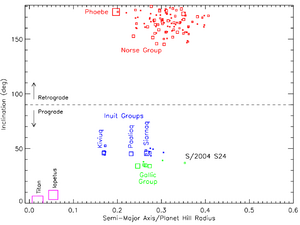Norse group facts for kids
The Norse group is a large collection of moons that orbit Saturn. These moons are called "irregular" because they have unusual orbits. Unlike most moons, they travel around Saturn in the opposite direction, which is called a retrograde orbit. They also orbit very far from Saturn.
Contents
What Makes the Norse Group Special?
These moons orbit Saturn at distances between 12 and 24 million kilometers. Their paths are also very tilted, ranging from 136 to 175 degrees compared to Saturn's equator. Their orbits are also quite stretched out, not perfectly round.
Unlike some other moon groups of Saturn, like the Inuit group or Gallic group, the Norse group moons are spread out more. This means they might actually be made up of several smaller groups of moons.
Naming the Moons
The International Astronomical Union (IAU) is the group that names planets, moons, and other space objects. For the Norse group moons, they usually choose names from Norse mythology, especially names of giants.
There is one exception: the moon Phoebe. It's the largest moon in this group, but its name comes from Greek mythology. This is because Phoebe was discovered a long time before the other moons in the group.
Recent Discoveries
In October 2019, scientists announced the discovery of 17 new moons that are thought to be part of the Norse group. A team led by Scott S. Sheppard found these moons using the Subaru Telescope in Hawaii. Each of these new moons is about 5 kilometres (3.1 mi) wide.
One of these newly found moons is the farthest moon ever discovered orbiting Saturn! After their discovery, a public contest was held to name these new moons. People could suggest names, but they had to be from Norse mythology. In August 2022, ten of these moons officially received their new names.
Members of the Norse Group
Here is a list of the moons in the Norse group, ordered by how far they are from Saturn:
- Phoebe (part of the Phoebe subgroup)
- S/2006 S 20 (part of the Phoebe subgroup)
- S/2006 S 9
- Skathi
- S/2007 S 5
- S/2007 S 7
- S/2007 S 2
- S/2004 S 37
- S/2004 S 47
- S/2004 S 40
- S/2019 S 2
- S/2019 S 3
- S/2020 S 7
- Skoll
- S/2020 S 2
- S/2019 S 4
- S/2004 S 41
- S/2004 S 42
- Hyrrokkin
- Greip
- S/2004 S 13
- S/2007 S 6
- Mundilfari
- S/2006 S 1
- S/2004 S 43
- S/2006 S 10
- S/2019 S 5
- Gridr
- Bergelmir
- Jarnsaxa
- Narvi
- Suttungr
- S/2007 S 3
- S/2004 S 44
- S/2004 S 45
- Hati
- S/2004 S 17
- S/2006 S 11
- S/2004 S 12
- Eggther
- S/2006 S 13
- S/2007 S 9
- S/2019 S 7
- S/2019 S 8
- Farbauti
- Thrymr
- Bestla
- S/2019 S 9
- S/2004 S 46
- Angrboda
- S/2019 S 11
- Aegir
- Beli
- S/2019 S 10
- S/2019 S 12
- Gerd
- S/2019 S 13
- S/2006 S 14
- Gunnlod
- S/2019 S 15
- S/2020 S 6
- S/2004 S 7
- S/2006 S 3
- S/2005 S 5
- Skrymir
- S/2006 S 16
- S/2006 S 15
- S/2004 S 28
- S/2020 S 8
- Alvaldi
- Kari
- S/2004 S 48
- Geirrod
- Fenrir
- S/2004 S 50
- S/2006 S 17
- S/2004 S 49
- S/2019 S 17
- Surtur
- S/2006 S 18
- Loge
- Ymir
- S/2019 S 19
- S/2004 S 21
- S/2019 S 18
- S/2004 S 39
- S/2019 S 16
- S/2004 S 53
- S/2004 S 36
- Thiazzi
- S/2019 S 20
- S/2006 S 19
- Saturn LXIV
- Fornjot
- S/2004 S 51
- S/2020 S 10
- S/2020 S 9
- Saturn LVIII
- S/2019 S 21
- S/2004 S 52
See also
 In Spanish: Grupo Nórdico para niños
In Spanish: Grupo Nórdico para niños


